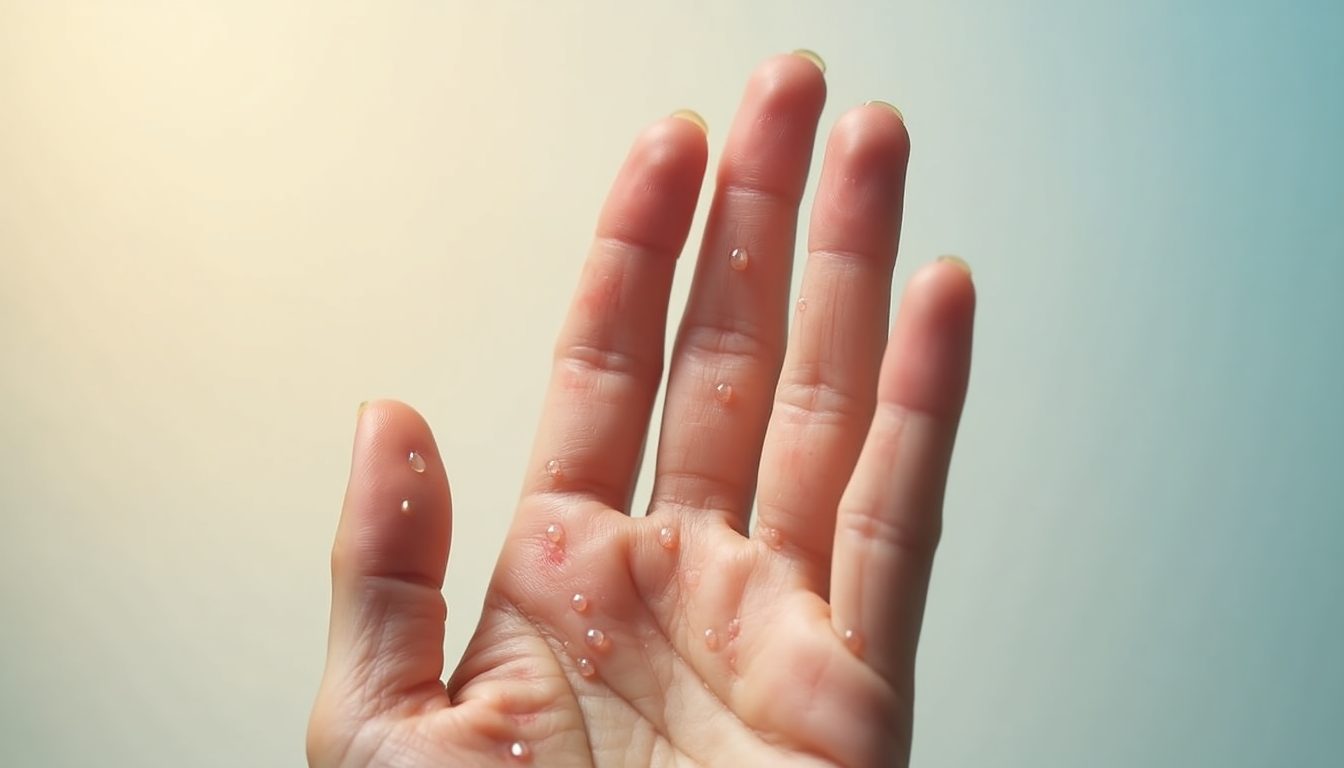Dyshidrotic Eczema: A Doctor’s Guide to Those Mysterious Stress Bumps on Fingers
Those tiny, itchy blisters appearing on your fingers during stressful times aren’t just a coincidence. These mysterious bumps are often signs of dyshidrotic eczema, a specific type of skin condition that affects the hands and feet.
Many people notice these fluid-filled blisters emerge during particularly stressful periods or seasonal changes. While the exact cause remains complex, doctors have identified several triggers that can spark these uncomfortable outbreaks.
This comprehensive guide explores the causes, symptoms, and most effective treatments for managing these stress-related skin bumps. Whether you’re dealing with your first outbreak or seeking better ways to control recurring episodes, you’ll find practical, doctor-approved solutions to help you understand and manage this condition.
Understanding Dyshidrotic Eczema Basics
Dyshidrotic eczema manifests as small, fluid-filled blisters that develop specifically on the palms, soles of feet, and edges of fingers and toes. These stress bumps, medically known as pompholyx, form a distinct pattern that sets them apart from other skin conditions.
What are stress bumps?
These mysterious bumps are actually tiny vesicles filled with fluid that appear suddenly on specific areas of hands and feet. The blisters often resemble tapioca pudding in appearance and can cluster together to form larger blisters. Notably, these blisters typically affect both sides of the body simultaneously, making the condition particularly distinctive.
Common symptoms to watch for
Before visible signs appear, many people experience:
- Intense itching or burning sensation
- Prickling feeling beneath the skin
- Small, fluid-filled blisters
- Peeling and cracking skin as blisters heal
- Possible skin discoloration after healing
The blisters typically clear within 3-4 weeks. Furthermore, some individuals experience wet, sweaty skin around the affected areas. Accordingly, the skin can become red, thickened, and develop painful cracks if left untreated.
Who gets affected most?
Dyshidrotic eczema predominantly affects adults between 20 and 40 years of age. Women are twice as likely to develop this condition compared to men. Additionally, certain factors increase the risk of developing this condition, including:
Having another form of eczema, specifically atopic dermatitis, raises the likelihood of developing dyshidrotic eczema. Essentially, about 50% of people with dyshidrotic eczema also have other types of eczema or a family history of atopic conditions. People working in specific professions, such as metalworkers, mechanics, or those frequently exposed to wet conditions, face a higher risk of developing this condition.
Common Triggers and Causes
Research reveals fascinating connections between our body’s stress response and skin health. When facing stressful situations, the body releases specific hormones that directly affect skin conditions.
Stress and anxiety factors
The relationship between stress and dyshidrotic eczema operates through complex biological mechanisms. Primarily, stress triggers the release of cortisol, which can disrupt immune system function and increase inflammation throughout the body. A landmark 2020 patient survey found that stress was the single biggest trigger of eczema flare-ups, with 57% of women and 41% of men reporting stress-induced outbreaks.
Moreover, this creates a challenging cycle – stress triggers flare-ups, which then cause more stress, making the condition harder to manage. The body’s fight-or-flight response, activated during stressful periods, releases cortisol in amounts that can suppress the immune system and worsen skin inflammation.
Environmental triggers
Beyond psychological factors, numerous environmental elements can trigger dyshidrotic eczema outbreaks. These triggers often work in combination with stress to exacerbate symptoms. Common environmental factors include:
- Seasonal changes and weather fluctuations
- Contact with metals like nickel and cobalt
- Exposure to chemical irritants in soaps and detergents
- Prolonged water exposure, particularly affecting those in healthcare or hairdressing professions
Temperature variations and humidity levels play significant roles in triggering outbreaks. Consequently, almost any weather change – from cold to hot, dry to humid – can affect the condition. Research indicates that individuals with dyshidrotic eczema have compromised skin barrier function, therefore making them more susceptible to environmental irritants and allergens.
The workplace environment deserves special attention, as certain occupations face higher risks. Jobs requiring frequent hand-washing or exposure to chemicals can significantly increase the likelihood of flare-ups. Nevertheless, understanding these triggers helps in developing effective management strategies.
Suggestion for read: Stimming Explained: What Nobody Tells You About This Natural Behavior
Getting the Right Diagnosis
Seeking medical attention at the right time makes a significant difference in managing dyshidrotic eczema effectively. A proper diagnosis helps determine the most suitable treatment approach and rules out other skin conditions.
When to see a doctor
Schedule an appointment with a healthcare provider if blisters appear on your hands, fingers, or feet. Medical attention becomes urgent primarily in these situations:
- Blisters become extremely painful
- Yellow or green fluid leaks from blisters
- Yellow-brown crusts form over the affected areas
- Signs of infection develop
Indeed, some people might develop cellulitis, a serious infection that occurs deep within the skin. Hence, prompt medical attention prevents complications and ensures proper treatment.
What to expect during examination
A board-certified dermatologist typically conducts a thorough evaluation through several steps. Initially, they perform a detailed skin examination, focusing on the affected areas. Subsequently, the doctor reviews your medical history and asks specific questions about:
- Your overall health condition
- Work environment and hobbies
- Pattern of blister development
- Recent lifestyle changes
- Metal implants in your body
- Recent medications, including birth control pills
- Exposure to materials like cutting oil or cement
The diagnostic process might include additional tests. For instance, if your dermatologist suspects a fungal infection, they may take skin scrapings for mycology testing. Although rare, a skin biopsy might be necessary in certain cases.
Patch testing often plays a crucial role in diagnosis, primarily when chronic cases suggest possible allergic reactions. During this procedure, small amounts of potential allergens are placed on your skin, usually on your back, to identify specific triggers.
